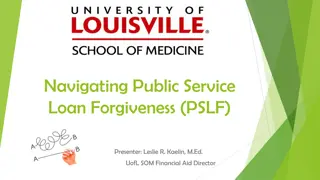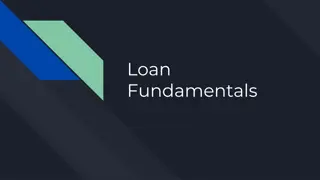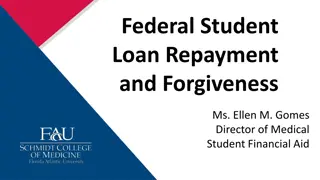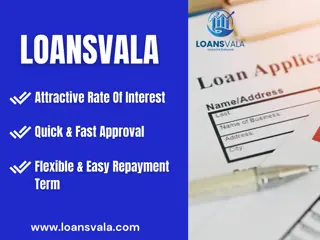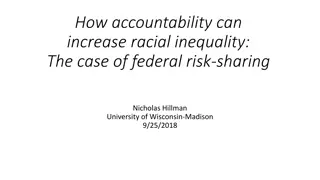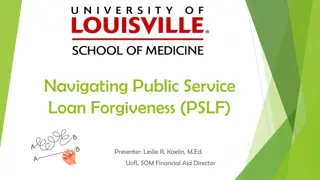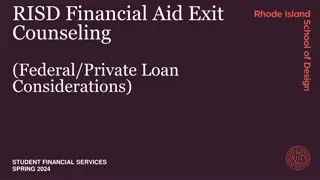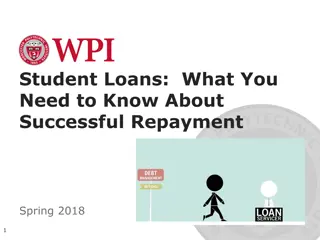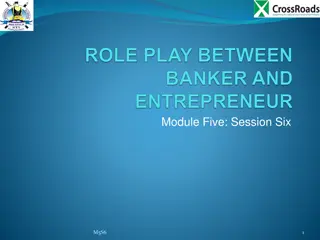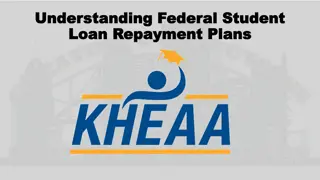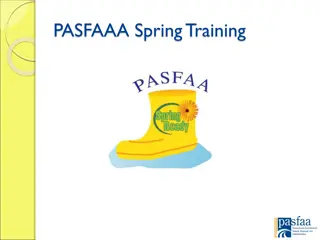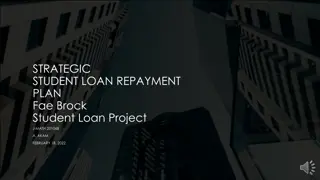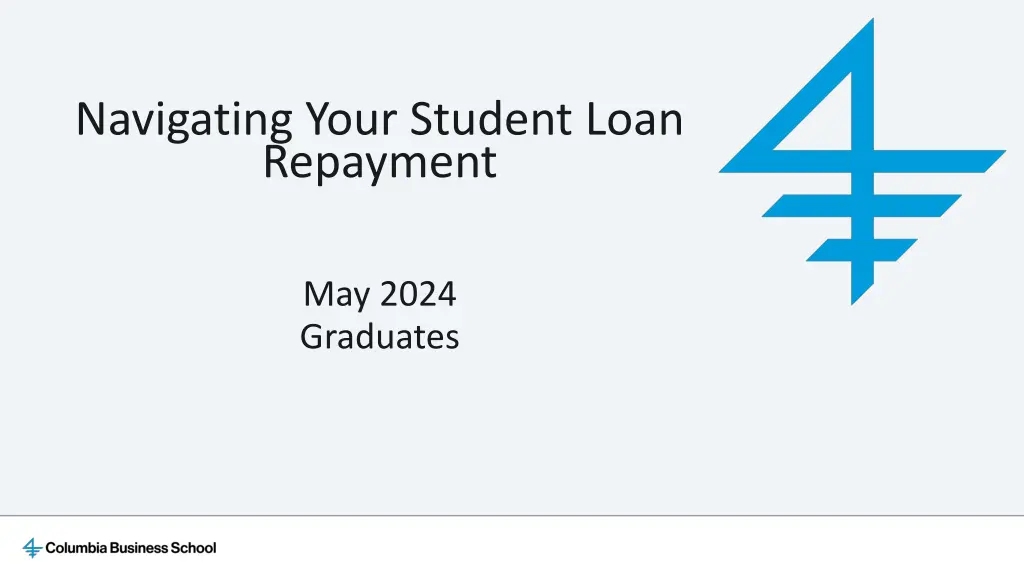
Navigating Student Loan Repayment Strategies for 2024 Graduates
Explore comprehensive resources and tips for managing student loan repayment after graduating in May 2024. Learn about loan portfolio types, debt management strategies, COVID-19 CARES Act implications, and how to determine the best repayment plan for your specific loans. Access additional resources, including repayment calculators and lender-specific websites, to navigate your student loan journey effectively.
Download Presentation

Please find below an Image/Link to download the presentation.
The content on the website is provided AS IS for your information and personal use only. It may not be sold, licensed, or shared on other websites without obtaining consent from the author. If you encounter any issues during the download, it is possible that the publisher has removed the file from their server.
You are allowed to download the files provided on this website for personal or commercial use, subject to the condition that they are used lawfully. All files are the property of their respective owners.
The content on the website is provided AS IS for your information and personal use only. It may not be sold, licensed, or shared on other websites without obtaining consent from the author.
E N D
Presentation Transcript
Navigating Your Student Loan Repayment May 2024 Graduates
Overview Determining Your Loan Portfolio What You Borrowed and Where to Find it Debt Management Repayment Plans, Strategies, Other Considerations COVID-19 CARES Act Next Steps What to Expect and When to Take Action Q&A
Additional Resources Graduation Matrix Understanding Loan Types Prodigy Finance Loan Program Details Repayment Plan Summary Chart Federal Repayment Plans (detailed) Lender-Specific Websites Repayment Calculators Default, Delinquency Look for these at the end of the presentation
Determining Your Loan Portfolio The 2024 Graduate has a loan portfolio that may contain any or all of the following loan types: Direct Unsub Fixed rate Direct Grad Private Consolidation Federal PLUS Fixed rate Fixed rate Fixed/Variable Perkins Stafford (prior degree) Fixed and serviced separately Variable
Determining Your Loan Portfolio What types of education loans do you have? How many loans do you have? Federal Stafford/Direct Loans, Consolidation Loans, Graduate PLUS loans, private loans, prior loans from other degrees, etc. Who is the lender or servicer for each of your student loans? Sometimes the lender is one entity but the servicer is completely different. Your federal loan servicer may be changing be sure to keep your contact information up-to-date with your current servicer. How much and when did you borrow each loan? This will help you determine the best repayment option and calculate any accrued interest
Determining Your Loan Portfolio Federal Student Aid Information Center (FSAIC) Lender-Specific Websites SSOL ssol.columbia.edu ssol.columbia.edu Will show original principal balances borrowed while at Columbia (for all schools attended) Go to Financial Aid => Student Loan History Central contact for federal student loans Can provide servicer and contact information Call 1-800-433-3243 Private Lenders Log in using borrower-specified username and password
Debt Management Before you choose your Loan Repayment Terms, you need a plan. Choose a repayment timeline to meet financial goals. When it comes to determining a repayment strategy to fit your needs, remember that a one size fits all approach does not work. Don t copy your friends: Different priorities = different goals = different needs Be sure to consult with your loan servicer and use the tools at your disposal. Repayment strategies are borrower-specific and tailored to meet the borrower s financial goals, for example: Pay student loan debt quickly Pay higher rate debt first Save to buy a house, start a family Relocate, go into business, etc. Working in public sector There are no prepayment penalties on student loans so please keep this in mind as your salary increases and as you consider your bonuses.
Debt Management: CARES Act The initial CARES Act (Coronavirus Aid, Relief, and Economic Security Act) and subsequent extensions include a number of provisions of interest to student loan borrowers. This provision was been in effect since March 13, 2020, and expired on August 30, 2023. This means your balance on loans such as Direct Unsubsidized and Direct PLUS (Grad PLUS) remained the same during this time. This provision applied to all borrowers with these loans.
Federal Repayment Plans Default plan for Direct Unsubsidized and Graduate PLUS Same payment each month for 120 monthly payments Level (10 Years) Graduated Lower initial payments that increase every few years (10 Years) Extended Graduated or Level Must have total indebtedness in federal loans of at least $30,000 (up to 25 Years) 4 Plan Options: Saving on a Valuable Education (SAVE), Income Based Repayment (IBR), Pay As You Earn (PAYE), Income Contingent Repayment (ICR) Income-Driven
Example Repayment (Level 10 Years)* *Amounts are estimated
Private Loan Repayment Considerations Private loans may have a fixed or variable rate. You may review your promissory note/loan agreement to confirm your rate or you may reach out to your lender. Accrued interest paid by borrower or capitalized at repayment Generally, repayment period is 7-20 years Determined at the time of application, at repayment, or based on your total borrowed amount check with your lender on your options 6-month grace period Managing variable rate private loans Payment amounts can change monthly, quarterly, or annually, depending on the loan terms Harder to forecast Requires more careful budgeting Example below assumes a $36,500 original principal and 10-year repayment Interest Rate Monthly Payment Amount 3.25% $369 5.25% $413 7.25% $461 9.25% $512
No Cosigner Loans: Repayment Options Prodigy prodigyfinance.com Payment options include auto-debit from a U.S. bank account, wire transfer, FlyWire, or Wise MPOWER mpowerfinancing.com Payment options include electronic through your MPOWER account or international money transfer
Strategies for Repayment Private Loan Refinancing Several lenders have come to market with a refinance loan. This loan is a private loan and unrelated to the federal loan consolidation product. Borrowers who need flexible repayment options, are considering careers in public service or non-profit, or who are not comfortable with the uncertainty of borrowing through a start-up should not consider this loan product. This loan product is likely only beneficial to those who plan to repay their loans quickly, have no worries related to unemployment or economic hardship, or who will never need a repayment plan to coincide with their income levels.
Strategies for Repayment Private Loan Refinancing Additional Considerations If you are planning to apply for a mortgage, the ability to lower your required monthly payment by extending your repayment plan under the federal loan program may be beneficial Underwriters consider your monthly debt-to-income in determining how much you can afford in a mortgage There is no ability to refinance back into the federal loan program once you refi into a private loan you forfeit all of the benefits associated with the federal loan program for the loans you have refinanced Additional consideration should be given to the timing of refinancing given the current 0% interest rate on federal loans effective until August 31
Prepayment Consideration Do you have an established emergency fund? Should I focus on prepayment? Lowering your debt is great, but in times of uncertainty, consider where this falls in your list of financial priorities. Most loans have deferment and forbearance options to forgo payments during periods of financial difficulties but chances are your rent or mortgage will still be due each month. Housing > Lowering your Debt
Deferment and Forbearance What is deferment? If you find that you are unable to meet your monthly payment obligations, contact your loan servicer right away. You may qualify for a deferment that will allow you to postpone making principal payments on your loan. The most common deferments granted are those for: In-school periods ------------granted without time limit Unemployment ------------applied for annually for up to 36 months maximum Economic hardship -------applied for annually for up to 36 months maximum Other deferment options may be available contact your servicer What is forbearance? For borrowers with temporary financial issues who do not meet the requirements for deferment, you may suspend your payments under certain circumstances by requesting forbearance. You will be responsible for the interest that accrues on your loan. This interest is added to the amount you owe when you re-enter repayment and must be repaid when payments resume. Forbearances are at the loan servicer s discretion and many have a cap on how long a forbearance can last. Use this sparingly in case of an emergency down the road. You must apply for a deferment or forbearance when not in school it is not automatic.
Strategies for Repayment Consider paying down/off interest before it capitalizes Interest is capitalized on your federal Direct Unsubsidized loan and most private loans just before you enter repayment; the federal Graduate PLUS loan may capitalize just prior to graduation and again just before you enter repayment Up to $2,500 in interest payments may qualify for a tax deduction more information may be found in IRS Publication 970 (income caps apply) Debt Stacking Pay down your highest interest/riskiest debt first Credit card debt May want to consider paying down private loans before federal even if the interest rate is currently lower Overpayments toward the principal (PREPAYMENT) Request the lowest minimum required payment possible to put more money in your pocket THEN => Make the minimum payments AND an additional overpayment and request that overpayments be applied directly to the principal of your most expensive loans
Power of Prepayment! By prepaying $500 per month on a loan fixed at 7% and an original principal of $60,000 you would save Number of Monthly Payments Length of Repayment Total Paid Interest Paid 25 years 300 $127,643 $67,643 25 years With prepay 82 $75,629 $15,629 Savings! 218 $52,014 $52,014
Loan Assistance and Loan Forgiveness Programs Loan Assistance Programs (LAP) and loan forgiveness may be available if borrowers qualify and funding is available. Programs typically are sponsored/funded by: School of attendance Tamer Center for Social Enterprise https://business.columbia.edu/socialenterprise/careers/loan-assistance October 15 deadline Employer Employers have begun instituting student loan repayment benefits If your employer does not offer this type of benefit ask! Federal, state or local government/jurisdiction Public Service Loan Forgiveness Program (Federal PSLFP) Will discharge the remaining debt after 10 years of full-time employment in public service Borrower must have made 120 qualified payments under IDR plan as part of the Direct Loan program in order to obtain this benefit. Only payments made on or after October 1, 2007 count toward the required 120 monthly payments There are many restrictions to this type of loan forgiveness. Please research this thoroughly before committing to it.
Next Steps Make sure your loan servicers have current contact info! Missing one payment could mean the loss of an incentive or increase to your interest rate (private loans) Avoid delinquency and default Sign up for online services Private loans generally have a 6 or 9 month grace period check with the lender Unsubsidized, and Grad PLUS loan payments begin 6 months after graduation Consolidation do not have a grace period repayment will begin within 60 days of first disbursement If you took a leave of absence you may have used your grace period Your first payment will come due before you know it!
Next Steps Summary Identify all loans borrowed and when they go into repayment plug the dates into your electronic calendars If you have outstanding loans from prior degrees, your loan repayment will begin again immediately at graduation. Come up with a repayment strategy that best suits your needs, financial plans, salary, bonuses, etc. Log onto the lender/loan servicer websites and call them to: Sign up for ACH auto-debit Update addresses and other contact information Review your loans and use loan repayment calculators to estimate monthly payments Inform them of any difficulties you are having with loan repayment Make sure there are no HOLDS or account balances on your Columbia account diploma will not be released. Complete Loan Exit Counseling online
Contact Us: finaid@gsb.columbia.edu Drop-In Zoom Hours: M - F: 10:30am 12:30pm EST, Password 211086
Additional Resources Graduation Matrix Understanding Loan Types Detailed Prodigy Information Repayment Plan Summary Chart Federal Repayment Plans (detailed) Federal Repayment Plan Comparisons Lender-Specific Websites Repayment Calculators Deferment, Forbearance, Default, Delinquency
Graduation Matrix Loan Type Borrowing Year 2021-2022 2022-2023 2023-2024 *Fixed rate of 5.28% *6-month grace period before repayment begins *Fixed rate of 6.54% *6-month grace period before repayment begins *Fixed rate of 7.05% *6-month grace period before repayment begins Federal Direct ($20,500 Subsidized/Unsubsidized) *Fixed rate of 6.28% *Repayment aligned with Direct loan; 6-month post-enrollment deferment *Fixed rate of 7.54% *Repayment aligned with Direct loan; 6-month post-enrollment deferment *Fixed rate of 8.05% *Repayment aligned with Direct loan; 6-month post-enrollment deferment Federal Graduate PLUS *Variable/fixed rate *Repayment typically begins 6- months after full-time enrollment *Check with lender for details *Variable/fixed rate *Repayment typically begins 6- months after full-time enrollment *Check with lender for details *Variable/fixed rate *Repayment typically begins 6- months after full-time enrollment *Check with lender for details Private Loans *Check with prior institution *Check with prior institution *Check with prior institution Federal Perkins (prior degrees)
Understanding Loan Types Federal Direct Loan: Student loans that are regulated by the federal government. Capped at $20,500 per academic year for graduate and professional students. Subsidized Need-based with accruing interest paid by the government while the borrower is in school, during a grace period and during eligible deferment periods Offered to eligible graduate students prior to 7/1/2012 Unsubsidized Not need-based with accruing interest paid by borrower or capitalized at repayment Repayment begins six months after you leave school or drop to less than half time status (6 credits), whichever happens first. Interest Rates: Loans first disbursed on or after 7/1/19: fixed rate of 6.08% Loans first disbursed on or after 7/1/20: fixed rate of 4.30% Loans first disbursed on or after 7/1/21: fixed rate of 5.28% Loans first disbursed on or after 7/1/22: fixed rate of 6.54% Loans first disbursed on or after 7/1/23: fixed rate of 7.05% Standard 10-year repayment period (or, if selected, up to 25 years extended for debts over $30,000)
Understanding Loan Types Federal Graduate PLUS Loan: No annual or aggregate cap eligible to borrow up to the COA less other aid Not need-based with accruing interest paid by borrower or capitalized at repayment Repayment begins six months after you leave school or drop to less than half time status (6 credits), whichever happens first. Interest Rates: Loans first disbursed on or after 7/1/19: fixed rate of 7.08% Loans first disbursed on or after 7/1/20: fixed rate of 5.30% Loans first disbursed on or after 7/1/21: fixed rate of 6.28% Loans first disbursed on or after 7/1/22: fixed rate of 7.54% Loans first disbursed on or after 7/1/23: fixed rate of 8.05% Standard 10-year repayment period (or, if selected, up to 25 years extended for debts over $30,000)
Understanding Loan Types Federal Consolidation Loan: Fixed interest rate Weighted average of underlying loans rounded up to nearest 1/8% No grace period Repayment begins immediately (30-45 days from consolidation) Repayment terms up to 30 years depending on debt levels Not a refinance tool, just debt management Reasons to consider consolidation: Single statement billing Qualify for longer repayment term than the Standard Level 10 years Students must consolidate any federal loans borrowed under the FFELP into the Federal Direct Loan program if they want to take advantage of Public Service Loan Forgiveness (PSLF). Reasons to forego consolidation: Federal loans first disbursed on or after 7/1/06 already have a fixed rate and do not necessarily need to be consolidated You will lose the ability to target prepayment of higher interest rate federal loans If you extend repayment to 30 years, it will cost more in interest
Understanding Loan Types Private Loans (including U.S. cosigned loans for international borrowers) Terms differ depending on lender Check loan promissory note for specific terms Accrued interest paid by borrower or capitalized at repayment Generally, repayment period is 5 - 20 years depending on loan balance and lender Generally 6-month grace period depending on lender Interest rate is variable or fixed for the life of the loan depending on lender Cannot be consolidated under the Federal Direct Consolidation Loan Program
Understanding Loan Types Prodigy Loan (no cosigner loan) Variable rate tier was quoted when you first applied Accrued interest paid by borrower or capitalized at repayment Generally, repayment period is 7-15 years depending on when you borrowed 6-month grace period
Prodigy Loan: Responsibilities as a borrower The Prodigy Finance Loan program is funded by investors in our community that support the school by lending to our international students. Non-payment harms the community and puts future funding opportunities at risk On-time payment of your monthly loan obligation is expected from all student loan borrowers. Investors receive a reasonable return and are able to support schools beyond charitable giving. Prodigy Finance is then able to originate and service the loans to students. Borrowers are then able to complete their degrees at top schools and succeed in addressing their financing gaps. Prodigy Finance is starting to see some of their borrowers become investors once their loans are repaid.
Prodigy Loan: Repayment Timing* Early settlement without penalty is possible at any time February Graduates: Your first payment will be due November 28, 2024 and then on the 28th of each month payments received after the 28th are considered late and subject to late fees *February and October graduates should confirm their repayment start date directly with Prodigy Payments can take up to 10 working days to clear depending on from where and how you are paying please coordinate payment at least 10 days before the 28th of the month to allow transfer time. The amount due per month will vary as the US Libor rate changes and your loan is repaid, please see your statement for the due amount Allow for currency fluctuations between statement and payment Allow for transfer costs deducted i.e. ensure net amount is paid into Prodigy Finance Prodigy Finance recommends the use of an automated monthly transfer from your account. Debit order functionality will be available soon. Your loan term is 10 years (120 months) of repayment and you can prepay at any time
Prodigy Loan: Repayment Options The following options are available for payment. Please see your statement for account specific details: Auto-debit ACH payment from a U.S. bank account https://support.prodigyfinance.com/hc/en-us/articles/360000750938-How-to-set-up-a- recurring-auto-debit-ACH- Direct Wire transfer into Prodigy s HSBC accounts Country specific options exist to limit your exposure to currency fluctuations Wiring / Transfer costs apply FlyWire Online access from anywhere in the world (using PC or mobile) Direct transfers in your own local currency at competitive rates Online support while you make your payment Visit https://support.prodigyfinance.com/hc/en-us/articles/360002787657-How-do-I-make-a- payment-through-Flywire-\ Wise Paid into a local US Wise bank account Currency conversion and transfer fees costs apply, therefore ensure that total payment takes these costs into account May take up to 10 days to process must coordinate payment well in advance to ensure payment is received by the 28th of each month
Prodigy Loan: Late Payments/Delinquency Failing to make a payment has an impact on your status and your credit history Economic Hardship: If you are facing temporary financial difficulties, please simply contact Prodigy as soon as possible and they will be happy to work with you on your options. Normally a forbearance will be offered. Late payments: Late fees will be charged to you and your status to the alumni community is listed as late 6 months of non-payment: Results in being in default of the loan
Prodigy Loan: Default While Prodigy Finance will work with you to avoid default, it is important to note that their loans are enforceable in 150 countries. Regardless of the country you are in, there will be legal ramifications should there be a default. In addition, the following will occur: 1. Your default will be registered with your local credit bureaus and courts which can severely limit access to credit in the future, it can also affect your ability to find a job 2. Legal proceedings will take place at your expense and under international enforcement a public judgement will be made against you in your country of residence and in the UK 3. The full outstanding balance of your loan falls due immediately 4. Columbia will be informed of your default 5. Alumni who have invested their personal funds to provide you with a loan will be informed 6. Your local and regional alumni offices will be made aware of your default 7. Prodigy Finance will pursue legal recourse via an specialised international collections agency, with local agents Please do not default. Prodigy will work with you if you are facing issues.
Prodigy Loan: Contact Information Prodigy requires that you update their records as you change jobs, addresses, or any time your personal circumstances change. Simply email them at payments@prodigyfinance.com. Email/Address/Phone Email they need a non-Columbia email address from you Address & Phone please make sure you update your physical mailing address if you have moved as well as if you change your phone number. Family contact details If your next of kin, significant other or contact information for other family members who are references changes, please contact Prodigy Employment Details If there are changes to your job title, position, company, sector, salary or bonus changes, please contact Prodigy Need more help? Prodigy Finance, payments@prodigyfinance.com, +44 (0) 207 193 2832 OR 718 407 2445
Federal Repayment Plan Summary Chart Plan Payment Structure Maximum Payment Period Considerations - Highest initial payment - Lowest total interest - No negative amortization Standard Fixed 10 years - Interest only payments initially - Payments increase incrementally - No negative amortization - Monthly payments can t be more than three times greater than any other payment ( 3 times rule ) - Lowest initial payment without considering income - No negative amortization - To qualify in FFELP: - Federal debt must be > $30,000 - New federal borrower 10/7/98 Graduated Tiered 10 years Extended Fixed or tiered 25 years Income-Driven Repayment Plans: SAVE Plan PAYE Plan IBR Plan ICR Plan Adjusted annually based on: - Household AGI - Household size - Poverty guideline - State residence - 10%-20% of discretionary income, never more than the payment would be under the Standard Plan - Eligibility/payment amount re-evaluated annually - Negative amortization allowed Up to 25 years
Federal Repayment Plans (detailed) 5 Repayment Plans (All Federal Loans) 1) Level (10 years*) Level 10-Year Plan (Standard Repayment) is the default plan for Direct Subsidized/Unsubsidized and Graduate PLUS loans Monthly payment of principal and interest that remains the same throughout the repayment term Positive: Lowest cost you will pay the least amount of interest if you enroll in the Standard Repayment plan Drawback: Payments may be higher than some borrowers can afford *Federal consolidation loans may qualify for up to 30 years in repayment based on the amount of the consolidation loan and the total federal indebtedness of the borrower; the default repayment plan is the longest for which the loan qualifies. 2) Graduated (10 years) Lower initial payments which increase every few years Positive: Lower initial payments with predictable increases Drawback: Total interest paid is higher than level plan
Federal Repayment Plans (detailed) 3) Extended (up to 25 years Level or Graduated) This plan extends the repayment term for up to 25 years if your federal loans total more than $30,000 All your loans must have been disbursed after October 7, 1998 Must opt in Noconsolidation required Positive: Usually offers the lowest monthly payment option without consideration of income Drawback: Total interest paid will be higher than shorter repayment terms
Federal Repayment Plans (detailed) 4) Income-Based Repayment (IBR) Available effective July 1, 2009 Must demonstrate partial financial hardship Caps monthly payments at 15% of your monthly discretionary income, where discretionary income is the difference between adjusted gross income (AGI) and 150% of the federal poverty line that corresponds to your family size and the state in which you reside Any outstanding eligible loan balance is cancelled after 25 year May be a taxable event Payment may be lower than the interest accrued monthly (negative amortization loans get bigger) Gov t waives/pays neg. amortization on Subsidized loans for up to 3 years under this repayment plan
Federal Repayment Plans (detailed) 5) Pay As You Earn (PAYE)* Available effective December 21, 2012 You must be a new borrower as of October 1, 2007 Must demonstrate partial financial hardship Caps monthly payments at 10% of your monthly discretionary income, will never exceed 10-year standard plan amount 20-year forgiveness May be taxable Payment may be lower than the interest accrued monthly (negative amortization loans get bigger) Gov t waives/pays neg. amortization on Subsidized loans for up to 3 years under this repayment plan *Also Revised Pay As You Earn (REPAYE) Similar to PAYE except payments may exceed the 10-year standard plan amount
Comparison of Federal Repayment Plans (Using $100K in Debt)* Example Borrower: $41,000 Federal Unsubsidized, average interest rate of 6.3% $59,000 Graduate PLUS loans, average interest rate 7.3% Income-Driven repayment plans assume single taxpayer in NY with starting AGI $60,000 Created using Dept. of Education website: https://studentaid.gov/loan-simulator/ You may login using your FSA ID to view estimates for your federal loans. *does not include interest accrual
Comparison of Federal Repayment Plans * ** *Forgiveness assumed based on PSLFP after 10 years **This amount should be consistent with IBR and PAYE.
Comparison of Federal Repayment Plans * * *Forgiveness assumed based on PSLFP after 10 years
Lender-Specific Websites Citizens citizensbank.com/student-services CollegeAve https://www.collegeavestudentloans.com/ Common Bond commonbond.co Discover discover.com/student-loans Earnest https://www.earnest.com/student-loans Laurel Road laurelroad.com/ Sallie Mae salliemae.com SoFi sofi.com SunTrust -- aessuccess.org Wells Fargo wellsfargo.com
Repayment Calculators CBS Grad Year/Program Specific Repayment Calculators (MBA/EMBA) Standard and Extended Repayment Prepayment Federal Repayment Estimator
Default/Delinquency If you fail to repay (default on) student loans, it can: Negatively impact your credit rating Prompt withholding of your federal and state tax refunds Limit your job selection (many companies run credit checks on job applicants) Rescind your professional license Trigger garnishment of your wages Raise the interest rate you pay on a car or home loan Personal bankruptcy rarely eliminates student loan debt Be sure to be in touch with your lender or loan servicer if you are experiencing any issues




